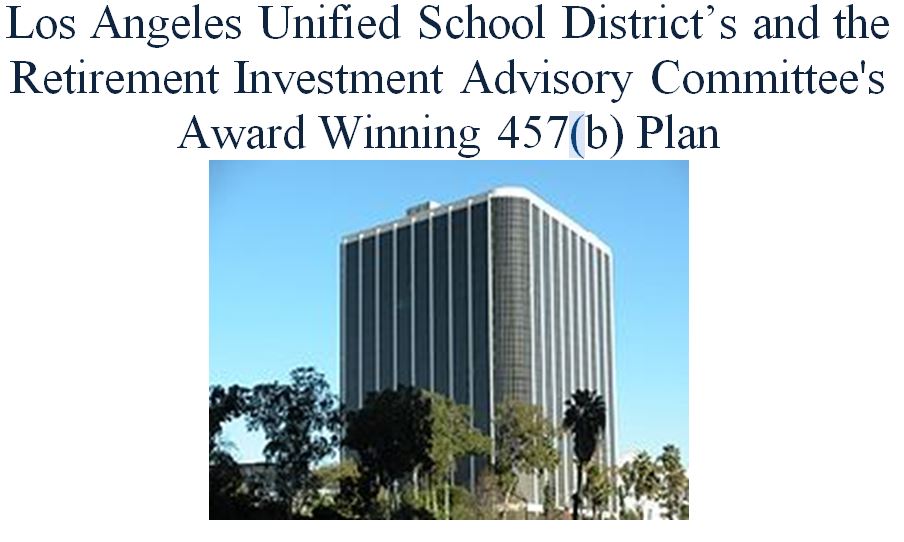Los Angeles Unified School District’s Headquarters in downtown Los Angeles
The word “passive” is hardly ever been a positive word in our aggressive, capitalistic, and materialistic-minded culture. We value and reward assertiveness and aggressiveness. We see the hero, always a lone wolf, played out in the media, movies, TV shows, the stories we tell ourselves and our children. The financial industry publicizes its own self-serving incentives and its so-called “heroes,” those coveted celebrity status investment managers who beat the market indexes. But the accolades from the financial media and many investors for assertiveness do NOT work with stock market investments over long periods. In this post, I will discuss the passive or indexing investment strategy and why I think it will improve LAUSD’s 457(b) plan. (Passive and indexing are interchangeable in investing).
Passive Wins!
For the past 20 years, the passive investing strategy using index funds has forever changed the investment world. And in 2023, this revolution keeps on going because more and more regular people demand low costs and simplicity so that we regular people can manage our investments and portfolio without hiring a financial adviser. Indexing made the self-managed investor possible because it is much less complicated than we think. Indexing has been around the investment world since legendary Jack Bogle started Vanguard and the first index, the S&P 500 index, in 1976. Fast forward half a century later, Bogle’s investment strategy has been verified by academics and financial industry studies. Furthermore and even more powerful are the hundreds of amateur podcasts and blog posts, such as my quarterly and my annual portfolio reports (Click here for 2022) going back five or six years that the passive strategy beats active management because of simplicity and low costs.
Active management is not just expensive, it is misleading at best and wrong at worst because it values, encourages, and supports short-term thinking. Most pensions, endowments, and foundations must plan for decades, and the use of index funds are now standard practice because it works with reduced costs over long periods of time. If it works for our pensions, why not us regular investors?
This series aims to share my thoughts and others more knowledgeable than me about the power of passive strategy for the stock and bond markets and our investments in the 2nd largest school district, Los Angeles Unified School District 457(b) plan. For starters, read Rich Ferri’s book, The Power of Passive Investing. ![The Power of Passive Investing: More Wealth with Less Work by [Richard A. Ferri, John C. Bogle]](https://m.media-amazon.com/images/I/51HxKeMh6gL.jpg)
Many authors are supporting the passive strategy: Bill Bernstein, JL Collins, Alan Roth, Larry Swardrow, and hundreds of blogs from the youthful Financial Independence and the Financial Independence Retire Early millenniums. For starters, take a peek at Mr. Money Mustache: https://www.mrmoneymustache.com/
For several years, I have discussed the passive strategy proposal for our award-winning 457(b) plan for Plan Design. LAUSD has a great 457(b) plan, but I want to improve on it with even lower-cost investments and simplicity. We can do it in one fell swoop by finishing the job of swapping out the most expensive actively managed funds for a few broadly diversified index funds. We have already been recognized for our low-cost, diversified investment selection that is wholly different from LAUSD’s 403(b) side. But now we can do more.
The primary reason we won a Plan Design award from the National Association of Governmental Defined Contribution Administrators (NAGDCA, 2014) was cost and a diversified selection of investments that grow with the economy, stock, and bond funds (NO ANNUITIES!)
Brief History
(For a complete history of how LAUSD’s 457(b) plan was born and how we lowered the original high-cost funds from 2006 to 2014, download my FREE pdf book Fighting Powerful Interests and look at pages 89-138)
Before we got the coveted NAGDCA award, our committee continued to improve the 457(b) plan by reducing costs from the 2006 original and expensive selection of investments ramrodded through our committee by our first consultant, the hideous Mercer Consultant lead rep. Yeah, they were “consultants” when their lead consultant left our committee as their LAUSD contract expired and promptly joined the very Third Party Administrator and record keeper that LAUSD’s just hired for the new 457(b)–VALIC. She blocked our efforts to use a different share class with lower revenue-sharing costs, which benefited VALIC. Yeah! You read that right! She now works for VALIC. As Jack Bogle said all of his life, “costs matter.”
Our Retirement Investment Advisory Committee (RAIC) has a colorful history of pathfinders. Our committee is unique because we have volunteer members representing each of the eight collective bargaining units. The people who actually pay the costs and represent their union constituents who also pay the costs sit on our committee, that’s what makes our committee unique. Very few employer-sponsored retirement plans have employees on their committees. I am honored and fortunate that I have been a member since 2006. We have an obligation to continue down that path of looking out for our teachers, administrators, and support personnel’s best financial interests.
This is 2023, not 2006! “The times are a changing.”
Right now, our committee, in my opinion, is at the next crossroad. Ten years ago, we got rid of those hideous revenue-sharing costs from Mercer for good. But since then, investment costs have dropped more! And that is good news, but we still have a few funds that need to be deleted and replaced with those current low cost opportunities. Our committee financial consultant says we have the all index fund option to recommend to the Chief Financial Officer (CFO), who makes the final decision. So what are we waiting for?
To argue my point to the committee, as some are new members and don’t know the history of the committee. I want to continue with our colorful history of fighting for lower costs and what we have accomplished in the last 17 years, which is revolutionary in the Defined Contribution (DC) world or 403(b), 457(b) and 401(k). Defined Benefit plans are Pensions (CalSTRS and CalPERS, and others) and institutional investment giants, endowments, and foundations that have employed indexing for years now or the passive strategy approach. What I have said all along, what I am proposing, is not new or revolutionary. Still, part of the natural order in DC plans has been going on for years and years, lowering costs, reducing choices, and offering broad diversification.
Please feel free to email me if you have any questions or want to support this effort.
Stay tuned for 2nd in the Series: The passive plan as envisioned by me that I will make to the committee. If you wish to be deleted from these notices, please unsubscribe.
Best of fortunes,
Steve
Steve’s Bio
Stephen A. Schullo, Ph.D. (UCLA ’96) taught in the Los Angeles Unified School District (LAUSD) for 24 years and at UCLA Extension teaching educational technology to student teachers. Steve wrote investment articles for the United Teacher-Los Angeles (UTLA) newspaper for 13 years. Thrice featured retirement plan advocate in the Los Angeles Times and U.S. News and World Report. He co-founded an investor self-help group (403bAware with a colleague, Sandy Keaton) for teacher colleagues and wrote 8,500 posts in three investment forums since 1997. Frequently quoted by the media, testified at California State legislative hearings and was honored with the “Unsung Hero” award by UTLA for his retirement planning advocacy. For the last seventeen years, he serves on LAUSD’s Investment Advisory Committee as a “Member-at-Large” and former co-chair. The committee monitors the district’s 457b/403b/PARS of 55,000 former and current LAUSD employees, worth $3.3 billion in total assets. Lastly, Steve and his late husband, Dan, were featured participants for the award-winning documentary PBS Frontline: The Retirement Gamble, aired on April 23, 2013.

